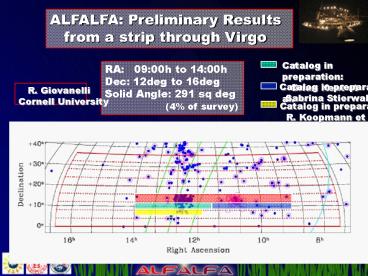ALFALFA: Preliminary Results - PowerPoint PPT Presentation
Title:
ALFALFA: Preliminary Results
Description:
ALFALFA detects 716 sources, HIPASS 40 (2 unconfirmed) ... ALFALFA does not detect a population of high mass (say 1010 solar), optically ... – PowerPoint PPT presentation
Number of Views:34
Avg rating:3.0/5.0
Title: ALFALFA: Preliminary Results
1
ALFALFA Preliminary Results from a strip
through Virgo
Catalog in preparation Brian Kent et al.
RA 0900h to 1400h Dec 12deg to 16deg Solid
Angle 291 sq deg (4 of survey)
Catalog in preparation Sabrina Stierwalt et al.
R. Giovanelli Cornell University
Catalog in preparation R. Koopmann et al.
2
(No Transcript)
3
(No Transcript)
4
?
Sources of log (HIMass)lt7.5 N12
N42
Parkes HIPASS survey Zwaan et al. 2003
5
Problem with Virgo/foreground Distances
RA Range 1144 1400 (largely Virgo)
0900 - 1400
6
(No Transcript)
7
HIPASS Completeness
HIPASS Limit
A Comparison with HIPASS
8
A Comparison with HIPASS, HIJASS, etc
- Over the 132 sq. deg. including the northern part
of Virgo, i.e. RA1144-1400, Dec14.-16.0 - ALFALFA detects 716 sources, HIPASS 40 (2
unconfirmed) - While this region is perhaps the most intensively
studied - in the local Universe, at all wavelength bands
(including - HI, using optically selected samples),
- ? 69 of ALFALFA detections are new (the
conventional - wisdom on which optical targets would turn
out to be - HI-rich appears to have been limited)
- Over the region of max HIJASS sensitivity
- ? ALFALFA detects 193 sources, HIJASS 15
9
czlt5000
- HI (ALFALFA)
- N1709
5000ltczlt10000
10000ltczlt18000
czlt5000
czlt18000
5000ltczlt10000
Optical ? N2529
10000ltczlt18000
czlt18000
10
- HI (ALFALFA)
- N1709
Optical ? N2529
11
Centroiding HI 20 (med)
12
So what do we find?
13
(No Transcript)
14
(No Transcript)
15
(No Transcript)
16
800 pc
Distance 8 Mpc
HPBW3.8x3.3
17
A high z LSB log(HI Mass)9.86
18
A low z LSB log(HI Mass)8.89
19
A nearby LSB log(HI Mass)7.75
20
A few goodies in Virgo
21
Two stray clouds
22
Brian Kent et al. (in preparation)
4.76 x 107 M?
7.29 x 107 M?
23
1o300 kpc
IC3068 BCD cz1288
24
1o300 kpc
IC 679 Sbc cz2213
25
The Cardiff Dark Galaxy
26
NGC 4254
10
DSS2 Blue
45 kpc
27
Combined ALFALFA data around NGC 4254
cz 2243 to 2557 km/s
10
45 kpc
Haynes et al. (in preparation)
28
Combined ALFALFA data around VIRGOHI21
cz 1946 to 2259 km/s
10
45 kpc
Haynes et al. (in preparation)
29
220 kpc
Minchin et al 2005 (WSRT)
Haynes et al. (in preparation)
30
Haynes et al. (in preparation)
31
A cloud complex
32
MHI 0.83E8 solar V 527 km/s W 120 km/s
MHI 0.52E8 solar V 601 km/s W 45 km/s
MHI 1.9E8 solar V 605 km/s W 257 km/s
235 kpc
MHI 1.7E8 solar V 490 km/s W 66 km/s
MHI 0.75E8 solar V 476 km/s W 48 km/s
100 km/s 100 kpc/Gyr
33
VCC1357 0.2x0.1 I? 603 km/s
34
NGC4424 3.6x1.8 SBa 476 km/s
35
- Cloud complex is in Virgo cluster
- Complex is not gravitationally bound
- Cloud-to-cloud Dv 100 km/s, Dr 100 kpc
- ? mean cloud separation will double in 1 Gyr
- ? cloud complex is transient phenomenon,
- at first pass through the cluster
- If individual clouds are bound their individual
- total masses average 1-2 x 10 9 solar
- Possible Origin
- Group of mini-halos falling in cluster for first
time - Separated outskirts from single spiral galaxy
- Satellites separated from main galaxy in group
HYDRO (Ram Pressure)? TIDAL (gravi)?
36
Galaxy harassment?
High velocity, - but long-lasting - encounters in
a cluster can drastically impact galaxy evolution.
Animation by G. Lake
37
A Void Dweller
Most of the mass within the HI boundaries is
accounted by the HI itself
cz3264 km/s MHI 3.5x108 Msun
GMRT Map
Amelie Saintonge et al. (2007, in prep)
38
Does metallicity correlate with local density?
galaxies in voids Popescu et al (1999) /
Hidalgo-Gamez et al (1998)
? Amelie Saintonge, Ph.D. Thesis, Cornell 2007
39
Extremely metal-poor galaxy
cz 280 km/s W 27 km/s F 0.64 Jy km/s D 6.3
Mpc log(MHI) 6.77
DSS2B
Alfalfa Spectrum
HI014127, a metal-poor galaxy Saintonge et al.
(in prep)
40
Extremely metal-poor galaxy
Most of the mass within the HI boundaries is
accounted by the HI itself
Ha
WISE (N.Brosch)
WIYN0.9m
log(O/H)12 7.4
Radius 400 pc
HI014127, a metal-poor galaxy Saintonge et al.
(in prep)
41
And then there are lots of narrow features, near
the noise, with no optical counterpart theyll
be chased one by one
42
some more credible than others
43
- The LSS characteristics of HI-selected galaxies
are the same as those optically-selected, albeit
with lower density contrast - ALFALFA does not detect a population of high mass
(say gt 1010 solar), optically inert systems
(e.g. Cardiff dark galaxy) - A number of optically inert systems are detected,
which appear to be of tidal origin - ALFALFA detects a numerically conspicuous pop of
HI-rich, optically faint, low mass systems
dynamics within the boundaries of the HI appear
dominated by the HI mass - Candidate sources w/o optical counterparts are
either of apparent tidal origin or have very
narrow (lt30 km/s) linewidths will need
corroboration - A population of HVCs with positive velocities
(czgt150 km/s) near the NGP may be related to
nearby, low mass galaxies
44
Were just getting started. Stay tuned






























